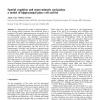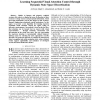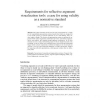61 search results - page 7 / 13 » Incremental Subspace Learning for Cognitive Visual Processes |
BC
2000
13 years 7 months ago
2000
Abstract. A computational model of hippocampal activity during spatial cognition and navigation tasks is presented. The spatial representation in our model of the rat hippocampus i...
ICIP
2003
IEEE
14 years 9 months ago
2003
IEEE
For effective retrieval of visual information, statistical learning plays a pivotal role. Statistical learning in such a context faces at least two major mathematical challenges: ...
NIPS
2000
13 years 8 months ago
2000
People can understand complex auditory and visual information, often using one to disambiguate the other. Automated analysis, even at a lowlevel, faces severe challenges, includin...
ICRA
2009
IEEE
14 years 2 months ago
2009
IEEE
² Similar to humans and primates, artificial creatures like robots are limited in terms of allocation of their resources to huge sensory and perceptual information. Serial process...
COMMA
2008
13 years 9 months ago
2008
This paper formulates in the first part some requirements for a certain sort of computational argumentation systems, namely those which are designed for a very specific purpose: to...



